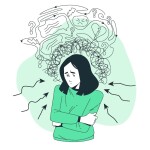Have you ever walked into a store, seen a price tag with a hefty discount, and thought, "What a steal!" only to later wonder if you truly got a good deal? That's not by accident, but rather a carefully crafted psychological phenomenon known as the anchoring effect. Businesses use this cognitive bias to influence your perception of value and nudge you into spending more than you intended.
In this blog, we will uncover the psychology behind the anchoring effect, how it is used in sales, its impact on your decision-making and mental health, and how you can outsmart it to become a more mindful consumer.
What is the Anchoring Effect?
The anchoring effect is a cognitive bias where an initial piece of information—the “anchor”—influences subsequent judgments and decisions. For example, if you’re shown a product priced at $100 and then see the same product discounted to $50, your perception of its value is shaped by the original price, even if the discounted price is not truly a bargain.
This bias extends beyond sales into everyday life. Just think of negotiations: the first number thrown out often forms the rest of the discussion. Even in social settings, how we initially perceive people provides an anchor for how we might view them. Understanding that this is a bias helps you see how it pervades so many aspects of life.
How the Anchoring Effect is Used in Sales
Businesses have learned how to take advantage of the anchoring effect in manipulating consumer behavior. Some of the most common tactics are as follows:
1. High Initial Price as an Anchor
When the initial price of a product is set high, that figure is your reference point. Even if the discounted price is still higher than the actual value of the product, it looks reasonable because your mind compares it to the original anchor.
For example: premium prices by brands to create an anchor is displayed through overpriced pieces. When an even relatively marginally priced piece is then available, it appears as an offer, though it also ends up being a price compared to the anchor.
2. Comparative Pricing
Business sometimes will introduce a high-ticket version of something just for the standard to seem by comparison more reasonably priced, because your brain will intuitively begin making these comparisons.
Example: Subscription services often have "Basic," "Standard," and "Premium" plans. The high premium price anchors your perception, and suddenly, the standard plan will feel like a decent mid-ground.
3. Premium Product First
Presenting more expensive items first sets an upper anchor. When you eventually face cheaper options later in life, they become way less pricey, although maybe overpriced themselves.
Example: In a restaurant, the most expensive dishes are usually listed first. This way, other dishes appear to be a bargain.
4. Price Anchoring During Sales
The most obvious application of the anchoring effect is during sales. Strikethrough pricing ("Was $100, now $50") creates a strong anchor that focuses attention on the "savings" rather than the actual value of the product.
For instance, the classic trick of Black Friday sales, which inflate "original prices" to be drastically cut and make a huge discount illusion.
Psychological Effects of the Anchoring Effect
The anchoring effect does not just influence your wallet but your emotions and mental health:
Perceived Savings vs. Actual Value: You could feel thrilled by a perceived bargain even though the actual savings are negligible or even nonexistent.
Emotional Reactions: You are likely to buy impulsively when a business appeals to the excitement, satisfaction, or urgency felt when purchasing.
Buyer's Remorse: Once the excitement has passed, you might feel buyer's remorse for spending money on something you did not really need or value.
The Ethics of Price Anchoring
Price anchoring, as a tactic, can be seen as brilliant marketing, but it becomes manipulative and crosses the thin line between influence and exploitation.
Ethical Use: Providing fair discounts and transparent prices that actually add value to the consumer.
Unethical Use: Inflating original prices or creating artificial scarcity to corner consumers into buying.
The more you know about these strategies, the better you can spot when a business is acting unethically.
Outsmarting the Anchoring Effect
Knowing about the anchoring effect gives you the edge to make more informed purchasing decisions. Here is how you can outsmart its pull:
Set a Budget: Decide how much you’re willing to spend before shopping and stick to it.
Do Your Research: Compare prices across different stores and platforms to establish your own anchor.
Avoid Impulse Buying: Take a step back and consider whether the purchase is necessary or just feels like a good deal.
Focus on Value: Assess the product’s quality and utility rather than being swayed by perceived savings.
Use Price Tracking Tools: Online tools can help you monitor price fluctuations and identify genuine discounts.
Role of Mental Health in Anchoring Susceptibility
Your mental state plays a significant role in how susceptible you are to marketing tactics. Stress, anxiety, or low self-esteem can make you more prone to impulsive buying and manipulation.
Stress and Anxiety: These emotions can impair decision-making, making you more likely to fall for anchoring tactics.
Mindfulness and Self-Control: With mindfulness, you may become aware and reflect on your decision before acting. Journaling the differences between needs and wants may help improve self-control techniques such as deep breathing.
Actual Scenarios of Anchoring Effect in Action
Here are some examples where anchoring effect is at work.
Black Friday Sales: People get caught up in buying what seems to be a deal when, in fact, it's only anchored by the original price and not necessarily the true discount.
Luxury Branding: Luxury brands use their flagship products as an anchor while making their lower-end product lines seem more reachable and still charge premium prices for them.
E-commerce Discounts: Online retailers frequently utilize countdown timers and "limited-time offers" that are anchored by some higher initial price.
Conclusion
The anchoring effect is a very powerful psychological tool that businesses use to influence your perception of value and drive your purchasing decisions. By understanding how this bias works and its impact on your emotions and mental health, you can take control of your shopping habits and resist manipulation.
The next time you go shopping, will you be anchored by the anchor, or will you steer your ship? Empower yourself with knowledge: the best deals are actually those that align with you and your needs and values.








